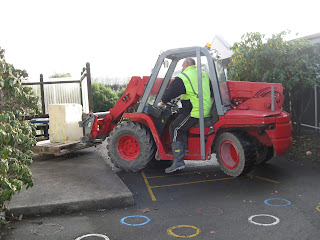We have been making a stone carving with Mr Briggs a professional stone carver.
After the 150th birthday of Harewood School we had some money left over and we decided to make a stone carving.
Mr Briggs worked on a design that represents Harewood School and our Maori culture. It includes the school logo, southern alps, 3 holes that represent the past, now and the future. It also has the Waimakariri river. There is a star which the girls in Kapa Haka have on their uniform.
 |
| Here comes our block of Oamaru stone |
 |
| Ooops! mind that judder bar!! |
First the man brought the piece of Oamaru stone on the forklift.
Next we drew the sketch to get the shape. Then we got 3 strong people to do the cutting. Next we cut the main shape of the carving. After that we drilled holes right through the carving and chiseled some creases with a chisel.
Next we drew the sketch to get the shape. Then we got 3 strong people to do the cutting. Next we cut the main shape of the carving. After that we drilled holes right through the carving and chiseled some creases with a chisel.
   |
Here are Mandy and Anarharia cheese grating. In this photo you can see the koura pattern and the pathway. If you cheese grate it is not like a saw, all it does is get the dust away.
THIS IS FUN
This is Conor wearing safety goggles. We all had to wear these so the dust wouldn't get in our eyes.
This is what the carving is going to be like hopefully. The tools we use are chisels, saws and cheese graters (rasps)
We are making great progress










































